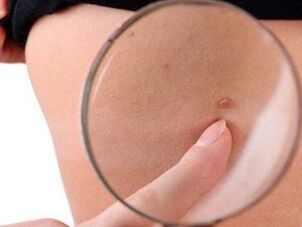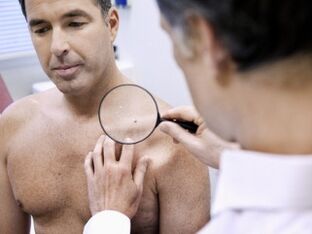
Many people suffer from papillomas on the body. Not a single person is insured against the appearance of the disease.
Unpleasant and sometimes even painful formations can occur in any person, regardless of gender and age.
Therefore, many people are interested in the question: "What causes papillomas? "Both men and women are equally susceptible to the development of pathology. The papillomavirus is very cunning.
Once it has entered the body, it remains there forever.
A person may be a carrier of the virus and not even suspect about it, because the symptoms of the disease do not appear immediately.
The worst thing is that it can infect other people. HPV symptoms only appear after the virus is activated, which is due to certain factors. The first and main manifestation of the disease is the formation of growths on the body (papillary processes attached to the skin with a small leg and having a pink or grayish color). Formations can form both on the mucous membranes and on the dermis (on the neck, eyelids, in the armpits, on the chest, as well as in intimate places - on the penis, labia).
Development reasons
Everyone should know what causes papillomas. Only knowing the main causes of the disease and the methods of infection can the occurrence of pathology be prevented. HPV after penetration into the body is in a dormant mode. The incubation period is from several months to several years.
The duration of this period depends on many reasons: health status, individual characteristics of the organism, as well as the state of the immune system. The root cause or what causes the appearance of papillomas on the body is HPV infection. The activation of the virus occurs under the influence of certain factors.
The build-up can be triggered by:
- weakening of the protective properties of the organism;
- genetic predisposition;
- promiscuous sexual intercourse;
- refusal to use contraceptives;
- transferred infectious diseases;
- the presence of chronic pathologies of internal organs;
- prolonged or inappropriate use of medications, in particular antibacterial agents;
- frequent stressful situations;
- avitaminosis;
- the presence of bad habits;
- ultraviolet radiation;
- non-observance of personal hygiene rules.
It should be understood that even a common cold can become a trigger for HPV activation. Therefore, it is necessary to preserve health and strengthen it.
Transfer mechanism
The papillomavirus is extremely widespread, it infects more than 70% of the world's population.
The virus can enter the body in several ways:
- Contact and household.Infection can be caused by even passing contact with the host's dermis. For this, it is enough that there is a scratch or microcrack on his skin. In addition, there is a high risk of contamination from household items in public places. You can get infected by visiting the pool or by holding onto the handrail on the bus. To prevent the penetration of HPV into the body, you must follow the rules of personal hygiene: wash your hands with soap, walk in the pool in shoes.
- Sexually.This is the most common transmission method. To date, there is no way to help prevent infection. Even the use of a condom is ineffective, since the contact of the outer mucous membranes of the intimate zone will occur in any case.
- Vertical path.Thus, children from mothers carrying the virus become infected. In the case when the mother has a neoplasm on the external genitals, it is quite understandable from what papillomas may appear in a child. In this case, infection occurs during the passage of the child through the birth canal.
HPV is dangerous and insidious. When its first manifestations - papillomas - appear, you need to make an appointment with a doctor. After carrying out the diagnosis and establishing an accurate diagnosis, the specialist will prescribe treatment. Do not hesitate to visit the doctor, especially if the neoplasms are hanging, often injured and rubbed with clothes.
It is important to understand that any injury to the growth or the development of an inflammatory process in it is fraught with infection and the development of a purulent process, as well as the transformation of a benign formation into cancer. Not a single person is immune from infection. But to make every effort to prevent infection is within the power of everyone. The main method of prevention is vaccination. If the infection has already occurred, the vaccine will not be effective.
Why papillomas appear on the body in pregnant women and in intimate areas in women
Papillomatosis in pregnant women is not uncommon. Pregnancy is not only a wonderful period of waiting for the birth of a child, but also a real test for a woman. It is during this period that women can develop pathologies that they have not encountered before. One of these troubles is the appearance on the dermis or mucous formations similar to warts - papillomas. Many women are interested in: "Why do papillomas appear on the body during gestation? "

The formation of neoplasms is usually determined by:
- decreased immunity;
- hormonal imbalance;
- the presence of chronic pathologies;
- rapid weight gain;
- by rubbing the dermis against the growth.
When papillomas appear on the body, make an appointment with a doctor. If the growths are small, do not hurt and are not injured, pathology therapy is postponed until later. It is carried out after childbirth or the end of the breastfeeding period. In the case when the size and number of formations is rapidly increasing, or they are exposed to friction and frequent damage, therapy is carried out immediately.
Papillomas in the genital area of women
The appearance of papillomas on the dermis gives a woman a lot of discomfort. These formations have an unaesthetic appearance, are often damaged and can transform into a malignant tumor. Formations in the intimate zone are of particular concern. The main reason for the appearance of papillomas on the genitals is HPV infection.
Infection can occur through sexual intercourse with a carrier of papillomavirus, infection during pregnancy or childbirth, sharing personal hygiene items, towels, washcloths, cosmetics. If papillomas are found in an intimate place, you need to consult a doctor.
Treatment of ailment must be prompt and appropriate. It is important to know not only why papillomas appear on the body, but also what the failure of therapy is fraught with. Ignoring the disease is fraught with disastrous consequences: severe damage to the build-up, infection and even degeneration into cancer.
Why papillomas are formed in men and how to remove papillomas in different ways
The causes of papillomas in men are the same as in women. The root cause of papillomas is HPV infection.
Virus activation and symptoms are caused by:
- the presence of addictions: frequent long-term smoking and alcohol abuse;
- decrease in the protective properties of the organism;
- violation of metabolic processes;
- the presence of gastrointestinal pathologies;
- genital inflammation;
- frequent change of sexual partners, promiscuous sex life.
Another reason for the appearance of papillomas in representatives of the strong half of society is non-compliance with the rules of personal hygiene. Formations in men can be localized on the skin, mucous membranes, genitals, scalp.
Regardless of the causes of the onset of the disease, therapy should be carried out immediately. You should know not only why papillomas are formed, but also that such formations are not as harmless as it might seem at first glance. As long as the growth does not hurt, itch, or damage, it is not dangerous. Damage to papillomas is fraught not only with the development of inflammation and infection, but also with transformation into a malignant tumor.
What happens if you tear off the growth
It is not worth cutting off or tearing off the formation, wherever it is located. This is fraught not only with the degeneration of the growth into cancer, but also with the spread of metastases to other organs. If the formation came off on its own, you should immediately consult a doctor.
After the cytological examination, the type of pathogen will be identified. If the formation is not oncogenic, the remaining tissue is removed. You can find out why papilloma was formed from a specialist. The doctor should deal with the therapy of the disease and only after all the necessary research has been carried out.
Removing formations

Pathology therapy should be comprehensive, including both conservative and surgical treatment.
To combat the virus, antiviral drugs are prescribed, and to remove growths, the following is prescribed:
- cryotherapy;
- radio wave treatment;
- electrocoagulation;
- laser therapy.
Traditional medicine
It is not uncommon for people to use alternative medicine to remove growths. Medicines from medicinal plants are good because they consist entirely of natural ingredients and help both to remove formations and strengthen the immune system. The most effective remedy in the fight against growths is celandine. It is recommended to lubricate the formation with freshly squeezed plant sap three times a day.
An infusion of kerosene and walnuts has proven itself well. It is necessary to fill a third of a glass liter bottle with chopped green milk walnuts. Next, you need to fill the raw material with refined kerosene and remove the tightly closed container in a cool place for three weeks.
It is necessary to treat the lesions with the filtered liquid twice a day. Dandelion tincture is also effective in the fight against the disease. Fill a 1/2 liter jar with fresh flowers. Next, the raw materials need to be poured with cologne. The product should be infused in a dark cool place for a month. Filtered liquid is advised to process growths four times a day.
Vaccination
Vaccination is the only way to prevent papillomas. The papillomavirus vaccine contains non-living HPV. This tool promotes the development of immunity to 4 major oncogenic strains of the virus. Routine vaccination is advised to take place at the age of 11, and tour vaccination is carried out in three doses. In order to prevent infection, a person should know why papillomas are formed and what is the risk of refusal of therapy.























